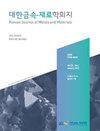Effect of Potassium Carbonate Additives on the Properties of Copper Foils Electroplated at High Current Density
IF 1.1
4区 材料科学
Q4 MATERIALS SCIENCE, MULTIDISCIPLINARY
引用次数: 0
Abstract
The amount and kind of additives in electrolytes play a very important role on the electroplating of Cu foil, which is used as a cathode materials for secondary batteries. As the use of Cu foil increased, various studies on the electroplated Cu foil are urgently needed. We studied surface characteristics and changes in structural properties due to the addition of inhibitors under electroplating conditions with high current density. The surface layer was observed, to analyze the effect of the amount of potassium carbonate as an inhibitor. When the potassium carbonate was added at 5~25 ppm without any other additives, the initial plating voltage was observed to decrease. To uniformly distribute crystals without agglomeration at the initial stage of electroplating, it is reasonable to add potassium carbonate within the range of 20~25 ppm. There was no significant difference in surface roughness and specific resistance due to the amount of potassium carbonate, when the additives were added complexly. There was an increase in the relative strength of the preferred growth orientation of (220) in a group with 20 ppm potassium carbonate, compared to the group with 10 ppm potassium carbonate. The grain size decreased with the amount of potassium carbonate added with other additives. However, there was no significant difference in tensile strength and elongation (p-value: 0.000). To ensure uniform properties with a combination of 4 kinds of additives it is reasonable to add potassium carbonate in the range of 10~20 ppm.碳酸钾添加剂对高电流密度电镀铜箔性能的影响
电解质中添加剂的含量和种类对二次电池正极材料铜箔的电镀有着重要的影响。随着铜箔使用量的增加,迫切需要对电镀铜箔进行各种研究。我们研究了在高电流密度的电镀条件下由于添加抑制剂而引起的表面特性和结构性能的变化。观察表面层,以分析碳酸钾作为抑制剂的量的影响。当在没有任何其他添加剂的情况下以5~25ppm的浓度加入碳酸钾时,观察到初始电镀电压降低。为了在电镀初期使晶体均匀分布而不结块,添加20~25ppm的碳酸钾是合理的。当添加剂添加复杂时,由于碳酸钾的量,表面粗糙度和电阻率没有显著差异。与具有10ppm碳酸钾的组相比,具有20ppm碳酸钾组中(220)的优选生长取向的相对强度增加。随着碳酸钾与其他添加剂的加入量的增加,晶粒尺寸减小。然而,拉伸强度和伸长率没有显著差异(p值:0.000)。为了确保4种添加剂组合的性能均匀,添加10~20ppm的碳酸钾是合理的。
本文章由计算机程序翻译,如有差异,请以英文原文为准。
求助全文
约1分钟内获得全文
求助全文
来源期刊

Korean Journal of Metals and Materials
MATERIALS SCIENCE, MULTIDISCIPLINARY-METALLURGY & METALLURGICAL ENGINEERING
CiteScore
1.80
自引率
58.30%
发文量
100
审稿时长
4-8 weeks
期刊介绍:
The Korean Journal of Metals and Materials is a representative Korean-language journal of the Korean Institute of Metals and Materials (KIM); it publishes domestic and foreign academic papers related to metals and materials, in abroad range of fields from metals and materials to nano-materials, biomaterials, functional materials, energy materials, and new materials, and its official ISO designation is Korean J. Met. Mater.
 求助内容:
求助内容: 应助结果提醒方式:
应助结果提醒方式:


